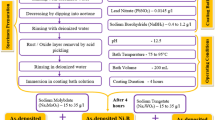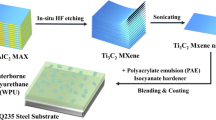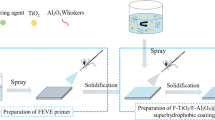Abstract
The effect of the copper content on properties of electroless Ni-Cu-P coating on heat exchanger surface was investigated, such as adhesion strength and surface characteristic, and anti-fouling property, which were considered to mitigate the accumulation of mineral fouling in the heat exchangers. The electroless ternary Ni-Cu-P coatings with different copper content were prepared on mild steel (1015) substrate surfaces by adjusting process parameters. Surface morphologies of coating and adhesion strength were investigated by using scanning electron microscopy (SEM) and MFT-4000 multifunctional material surface performance instrument, respectively. The results showed that the adhesion strength was improved with the addition of copper in the coating. With the increase of copper content, the deposition rate of ternary Ni-Cu-P coatings was increased, and the boundary of nodular became obvious. Moreover, the surface free energy of ternary Ni-Cu-P coatings was increased with the increase of copper content in the coatings and then decreased when enhancing the copper content further. The further fouling experiments indicated that all the ternary Ni-Cu-P coating surfaces with different copper content inhibited the adhesion of fouling compared with the stainless steel surface. The adhesion weight of fouling was approximately in proportion with the copper addition of ternary Ni-Cu-P coatings, but not the value of surface free energy. The work provides evidence that both adhesion strength and anti-fouling ability should be combined to use when applying surface modification in the field of heat exchanger.
Similar content being viewed by others
References
Al-Janabi A, Malayeri MR, Müller-Steinhagen H (2010) Experimental fouling investigation with electroless Ni-P coatings. Int J of Therm Sci 49:1063–1071
Kazi SN, Duffy GG, Chen XD (2012) Fouling and fouling mitigation on heated metal surfaces. Desalination 288:126–134
Bornhorst A, Müller-Steinhagen H, Zhao Q (1999) Reduction of scale formation by ion-implantation and magnetron sputtering on heat transfer surfaces. Heat Transfer Eng 20:6–14
Yang QF, Gu AZ, Ding J (2002) Calcium carbonate fouling behavior and morphology. J Chem Ind Eng 53:924–930
Yang SR, Sun LF, Xu ZM (2004) Development and prospect of research on heat exchanger fouling. Chem Ind Eng Prog 23:1091–1098
Cheng YH, Chen HY, Zhu ZC, Jen TC, Peng YX (2014) Experimental study on the anti-fouling effects of Ni-Cu-P-PTFE deposit surface of heat exchangers. Appl Therm Eng 68:20–25
Lee J, Kim TJ, Kim MH (2005) Experimental study on the heat and mass of teflon-coated tubes for the latent heat recovery. Heat Transfer Eng 26:28–37
Zhao Q, Wang X (2005) Heat transfer surfaces coated with fluorinated diamond-like carbon films to minimize scale formation. Surf Coat Technol 192:77–80
Rosmaninho R, Santos O, Nylander T (2007) Modified stainless steel surfaces targeted to reduce fouling—evaluation of fouling by milk components. J Food Eng 80:1176–1187
Ren XG, Li TF, Zhao Q (2006) Effect of surface treatment on flow boiling heat transfer coefficient in CaSO4 containing water. Chin J Chem Eng 14:122–126
Wang LL, Liu MY (2009), Antifouling and anticorrosion properties on surfaces of TiO2 nanometer films coated with liquid phase deposition, Proc. of Int. Conference on Heat Exchanger Fouling and Cleaning VIII-2009: 281–288
Cheng YH, Zou Y, Cheng L, Liu W (2009) Effect of the microstructure on the anti-fouling property of the electroless Ni-P coating. Mater Lett 62:4283–4285
Nemeth S (2008) Modelling of the scratch resistance of particle filled sol-gel coatings on aluminium. Thin Solid Films 516:5355–5359
Zhang WX, Huang N, He JG et al (2007) Electroless deposition of Ni-W-P coating on AZ91D magnesium alloy. Appl Surf Sci 253:5116–5121
Boentoro W, Pflug A, Szyszka B (2009) Scratch resistance analysis of coatings on glass and polycarbonate. Thin Solid Films 517:3121–3125
Krump H, Simor M, Hudec I, Jasso M, Luyt AS (2005) Adhesion strength study between plasma treated polyester fibres and a rubber matrix. Appl Surf Sci 240:268–274
Song WL, Deng JX, Yan P, Wu Z, Zhang H, Zhao J, Ai X (2011) Influence of negative bias voltage on the mechanical and tribological properties of MoS2/Zr composite films. J Wuhan Univ Technol Mater Sci Ed 126:412–416
Huang RX, Qi ZB, Sun P, Wang ZC, Wu CH (2011) Influence of substrate roughness on structure and mechanical property of TiAlN coating fabricated by cathodic arc evaporation. Phys Procedia 18:160–167
Cheng YH, Zou Y, Cheng L, Liu W (2009) Effect of the microstructure on the properties of Ni–P deposits on heat transfer surface. Surf Coat Technol 203:1559–1564
Connell CO, Sherlock R, Ball MD et al (2009) Investigation of the hydrophobic recovery of various polymeric biomaterials after 172 nm UV treatment using contact angle surface free energy and XPS measurements. Appl Surf Sci 255:4405–4413
Zhao Q, Liu Y (2006) Modification of stainless steel surfaces by electroless Ni-P and small amount of PTFE to minimize bacterial adhesion. J Food Eng 72:266–272
Author information
Authors and Affiliations
Corresponding author
Rights and permissions
About this article
Cite this article
Cheng, Y.H., Chen, S.S., Jen, T.C. et al. Effect of copper addition on the properties of electroless Ni-Cu-P coating on heat transfer surface. Int J Adv Manuf Technol 76, 2209–2215 (2015). https://doi.org/10.1007/s00170-014-6437-8
Received:
Accepted:
Published:
Issue Date:
DOI: https://doi.org/10.1007/s00170-014-6437-8




